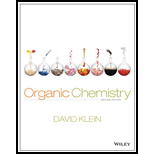
Organic Chemistry
2nd Edition
ISBN: 9781118452288
Author: David R. Klein
Publisher: WILEY
expand_more
expand_more
format_list_bulleted
Question
Chapter 4.12, Problem 11LTS
Interpretation Introduction
Interpretation:
The axial and equatorial chair conformation of Bromocyclohexane should be drawn.
Concept Introduction:
Conformational isomers:
- The two or more compounds have same molecular formula and different structural formulas are called conformational isomers.
- The cyclohexanes have a chair and boat conformations.
- The boat conformation of cyclohexane is more stable than boat form.
- The boat conformation of cyclohexane has two positions of substituent's which are axial and equatorial.
- The substituent occupy at similar to a vertical axis passing through the chair conformation of cyclohexane ring is called axial position.
- The substituent occupy at similar to a horizontal axis passing through the chair conformation of cyclohexane ring is called equatorial position.
To draw the axial and equatorial chair conformations of Bromocyclohexane.
Expert Solution & Answer
Want to see the full answer?
Check out a sample textbook solution
Students have asked these similar questions
Which compound would you expect to have a higher decomposition temperature,Na2CO3 or Cs2CO3? Justify your answer, but you do not need to do any calculations.
Can I get some help drawing my arrows. I included what the final needs to look like
please help
Chapter 4 Solutions
Organic Chemistry
Ch. 4.2 - Prob. 1LTSCh. 4.2 - Prob. 1PTSCh. 4.2 - Prob. 2ATSCh. 4.2 - Prob. 3ATSCh. 4.2 - Prob. 4ATSCh. 4.2 - Prob. 2LTSCh. 4.2 - Prob. 5PTSCh. 4.2 - Prob. 6ATSCh. 4.2 - Prob. 3LTSCh. 4.2 - Prob. 7PTS
Ch. 4.2 - Prob. 8ATSCh. 4.2 - Prob. 9ATSCh. 4.2 - Prob. 4LTSCh. 4.2 - Prob. 10PTSCh. 4.2 - Prob. 11ATSCh. 4.2 - Prob. 5LTSCh. 4.2 - Prob. 12PTSCh. 4.2 - Prob. 13ATSCh. 4.3 - Prob. 6LTSCh. 4.3 - Prob. 14PTSCh. 4.3 - Prob. 15ATSCh. 4.6 - Prob. 7LTSCh. 4.6 - Prob. 16PTSCh. 4.6 - Prob. 17ATSCh. 4.6 - Prob. 18ATSCh. 4.7 - Prob. 19CCCh. 4.8 - Prob. 8LTSCh. 4.8 - Prob. 20PTSCh. 4.8 - Prob. 21ATSCh. 4.11 - Prob. 9LTSCh. 4.11 - Prob. 22PTSCh. 4.11 - Prob. 23ATSCh. 4.11 - Prob. 10LTSCh. 4.11 - Prob. 24PTSCh. 4.11 - Prob. 25PTSCh. 4.11 - Prob. 26PTSCh. 4.11 - Prob. 27ATSCh. 4.12 - Prob. 11LTSCh. 4.12 - Prob. 28PTSCh. 4.12 - Prob. 29ATSCh. 4.12 - Prob. 30CCCh. 4.12 - Prob. 12LTSCh. 4.12 - Prob. 31PTSCh. 4.12 - Prob. 32ATSCh. 4.12 - Prob. 13LTSCh. 4.12 - Prob. 33PTSCh. 4.12 - Prob. 34ATSCh. 4.12 - Prob. 35ATSCh. 4.14 - Prob. 36CCCh. 4.14 - Prob. 37CCCh. 4.14 - Prob. 38CCCh. 4 - Prob. 39PPCh. 4 - Prob. 40PPCh. 4 - Prob. 41PPCh. 4 - Prob. 42PPCh. 4 - Prob. 43PPCh. 4 - Prob. 44PPCh. 4 - Prob. 45PPCh. 4 - Prob. 46PPCh. 4 - Prob. 47PPCh. 4 - Prob. 48PPCh. 4 - Prob. 49PPCh. 4 - Prob. 50PPCh. 4 - Prob. 51PPCh. 4 - Prob. 52PPCh. 4 - Prob. 53PPCh. 4 - Prob. 54PPCh. 4 - Prob. 55PPCh. 4 - Prob. 56PPCh. 4 - Prob. 57PPCh. 4 - Prob. 58PPCh. 4 - Prob. 59PPCh. 4 - Prob. 60PPCh. 4 - Prob. 61PPCh. 4 - Prob. 62PPCh. 4 - Prob. 63PPCh. 4 - Prob. 64IPCh. 4 - Prob. 65IPCh. 4 - Prob. 67IPCh. 4 - Prob. 68IPCh. 4 - Prob. 69IP
Knowledge Booster
Similar questions
- Can I get help on drawing my arrowsarrow_forwardCan I get helpp drawing my arrowsarrow_forwardWhich of the m/z values corresponds to the base peak in the mass spectrum shown? 100 80 A. 45 B. 44 C. 29 D. 15 Intensity 20 0 10 20 30 40 B- m/z -8 50 E. 30 Which of the m/z values correspond to the molecular ion for the compound shown? A. 18 B. 82 OH C. 100 D. 102 E. 103arrow_forward
- Please explain how to calculate the pH.arrow_forwardI'm having trouble with converting lewis diagrams into VSEPR diagrams. I currently have this example of C2BrCl3 which I want to turn into a lewis structure, but I'm not sure what steps I need to do in order to do so. I have the table written down, however, there's two central atoms so what would I do? There seems to be 4 electron domains on the carbon atom and no lone pairs so it would seem like this shape would be tetrahedral. Here's what I have now. Thanks!arrow_forwardWe discussed the solid phase resin using in peptide synthesis. Provide a mechanism, for its formation. DRAW THE MECHANISM.arrow_forward
arrow_back_ios
SEE MORE QUESTIONS
arrow_forward_ios
Recommended textbooks for you
 ChemistryChemistryISBN:9781305957404Author:Steven S. Zumdahl, Susan A. Zumdahl, Donald J. DeCostePublisher:Cengage Learning
ChemistryChemistryISBN:9781305957404Author:Steven S. Zumdahl, Susan A. Zumdahl, Donald J. DeCostePublisher:Cengage Learning ChemistryChemistryISBN:9781259911156Author:Raymond Chang Dr., Jason Overby ProfessorPublisher:McGraw-Hill Education
ChemistryChemistryISBN:9781259911156Author:Raymond Chang Dr., Jason Overby ProfessorPublisher:McGraw-Hill Education Principles of Instrumental AnalysisChemistryISBN:9781305577213Author:Douglas A. Skoog, F. James Holler, Stanley R. CrouchPublisher:Cengage Learning
Principles of Instrumental AnalysisChemistryISBN:9781305577213Author:Douglas A. Skoog, F. James Holler, Stanley R. CrouchPublisher:Cengage Learning Organic ChemistryChemistryISBN:9780078021558Author:Janice Gorzynski Smith Dr.Publisher:McGraw-Hill Education
Organic ChemistryChemistryISBN:9780078021558Author:Janice Gorzynski Smith Dr.Publisher:McGraw-Hill Education Chemistry: Principles and ReactionsChemistryISBN:9781305079373Author:William L. Masterton, Cecile N. HurleyPublisher:Cengage Learning
Chemistry: Principles and ReactionsChemistryISBN:9781305079373Author:William L. Masterton, Cecile N. HurleyPublisher:Cengage Learning Elementary Principles of Chemical Processes, Bind...ChemistryISBN:9781118431221Author:Richard M. Felder, Ronald W. Rousseau, Lisa G. BullardPublisher:WILEY
Elementary Principles of Chemical Processes, Bind...ChemistryISBN:9781118431221Author:Richard M. Felder, Ronald W. Rousseau, Lisa G. BullardPublisher:WILEY

Chemistry
Chemistry
ISBN:9781305957404
Author:Steven S. Zumdahl, Susan A. Zumdahl, Donald J. DeCoste
Publisher:Cengage Learning

Chemistry
Chemistry
ISBN:9781259911156
Author:Raymond Chang Dr., Jason Overby Professor
Publisher:McGraw-Hill Education

Principles of Instrumental Analysis
Chemistry
ISBN:9781305577213
Author:Douglas A. Skoog, F. James Holler, Stanley R. Crouch
Publisher:Cengage Learning

Organic Chemistry
Chemistry
ISBN:9780078021558
Author:Janice Gorzynski Smith Dr.
Publisher:McGraw-Hill Education

Chemistry: Principles and Reactions
Chemistry
ISBN:9781305079373
Author:William L. Masterton, Cecile N. Hurley
Publisher:Cengage Learning

Elementary Principles of Chemical Processes, Bind...
Chemistry
ISBN:9781118431221
Author:Richard M. Felder, Ronald W. Rousseau, Lisa G. Bullard
Publisher:WILEY